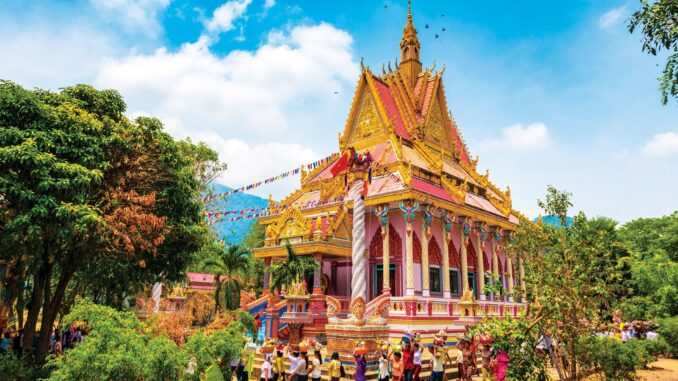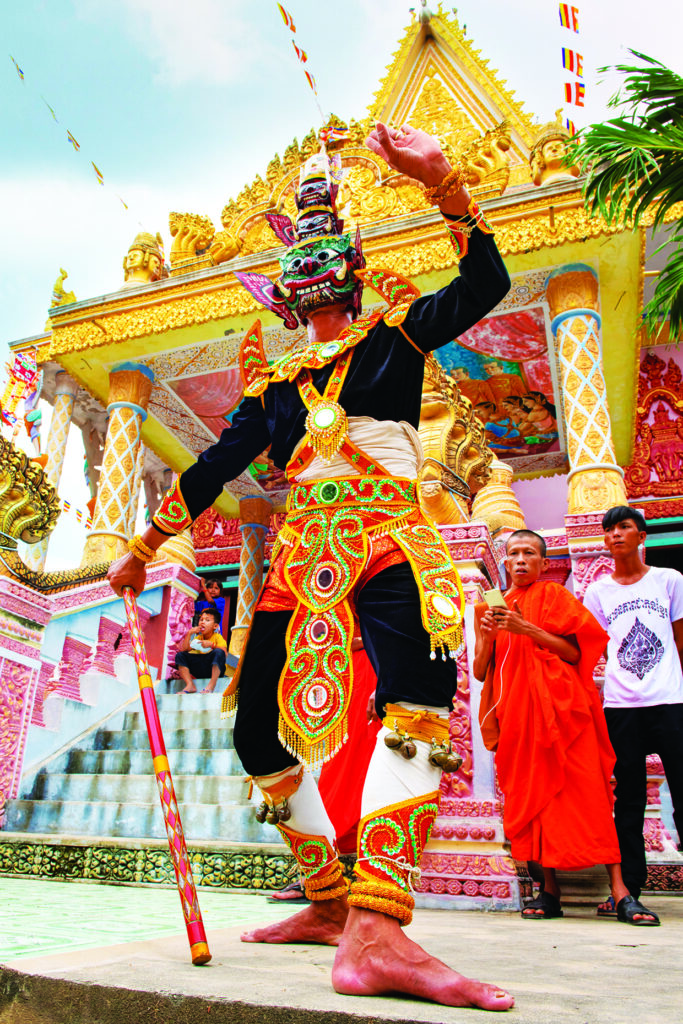
General information
Chol Chnam Thmay is a festival to celebrate the new year according to the traditional calendar of the Khmer people. “Chol” means “in” and “Chnam Thmay” means “new year”. Every year, the festival usually takes place around mid-April of the solar calendar, including many traditional ceremonies and folk games.
Chol Chnam Thmay is the biggest festival of the year of Cambodian people and of more than 1,3 million Khmer ethnic people living in many provinces in South of Vietnam such as Kien Giang, An Giang, Soc Trang, Tra Vinh, and Bac Lieu,… The festival has many similarities with the Bunpimay Festival of Laos, the Songkran Festival of Thailand, or the Thingyan New Year of Myanmar.
For the Khmer, April is the intersection between the dry and rainy seasons. At this point, the grass is back to being lush and nature comes to life. The change and flare of nature was conceived by the Khmer as the beginning of a new year. The celebration of Chol Chnam Thmay Festival comes from the purpose of praying for the dry season to pass quickly so that a new crop can be started.
Because it means welcoming the rainy season, new crops and is the biggest festival of the year, in the past, Chol Chnam Thmay Tet lasted from 10-15 days. In recent decades, in the trend of simplifying the festival in general, this festival has only 3 days left (not to mention the preparation work in the previous days).
Khmer New year days
- The first day is called Chol Sangkran Thmay. On this day, people often dress beautifully to come to the temple for praying. At the temples, there will be an Acha holding the whole ceremony. People line up to walk around the main hall thrice for the new year welcoming ceremony. After that, everyone celebrates at the temple.
- The second day is called Thngay Von-boch. Each family has to hold an offering of a morning meal and lunch for the monks in the temples. Before eating, the monk will chant thanks to the one making this meal. In the afternoon, there will be the “Sandhill making” ceremony (Puon Phnom Khsach) right at the temple’s campus under the guidance of the Acha. Khmer people believe that every single grain of sand on the sandy mountain represents a sin being eradicated and freeing a soul from hell. The sandy mountain is also like the clouds bring the rain to the upcoming harvest after drought months.
- The third day is Thngay Lom-sak. People wash the Buddha statue with fragrant water. They soak flowers in water, then use this water to wash the Buddha statue. After that, they also bathe the senior monks at the temple. Meanwhile, every local people also bathe with the fragrant water to wash away the unlucky things of the old years and welcome the new year with much luck.
These days, every family, even the poor ones, have to have a pot of num-chrut cake and num-tien cake. Num-chrut cake is a little similar to round glutinous rice cake of Kinh people while the num-tien cake is similar to the sweet sticky rice cake. These two kinds of cake represent the peace, and prosperity of the Khmer. At the pigsty and byre, there is enough straw for the animal to eat during the three days of Tet.
During the three days of the Chol Chnam Thmay Festival, people also organize the festival with many exciting activities such as drum dancing, kite flying, candlelight dance, etc. The Khmer also visit their relative’s house and wish each other peace, lucky and prosperous new year. During your tours in Vietnam, you may have opportunities to take part in this important festival of Khmer people.

Besides worshiping the Buddha, the Khmer also believe that each year, there is a god known as Tevada sent to the world to take care of the people and their life. Each Tevada has one year term, therefore, at the end of the year, the Tevada returns to the sky. Next year, there will be another Tevada take on the job. On new year’s eve, people usually decorate the altar with five branches of flowers, five candles, five incense, five nuts and many fruits. Parents and grandparents gather their children to sit down in front of the ancestors’ altars to farewell the old god and welcome the new god to their land.
We would be pleased to have you visit and take in our breathtaking scenery, unwind on our white sandy beaches, immerse yourself in our exquisite culture, and get to know the people of the friendliest nation. Especially, to savor our delicious food at restaurants with Michelin ratings or to come and participate in our incredible mega-events involving culture, music, sports, and tourism!
Make your plan to Vietnam right now by obtaining a Vietnam visa at https://www.vietnam-evisa.org. We, a reputable and reliable Visa service, will assist you turn your plan into reality at the very first step.
Source: vietnamoriginal-travel.com